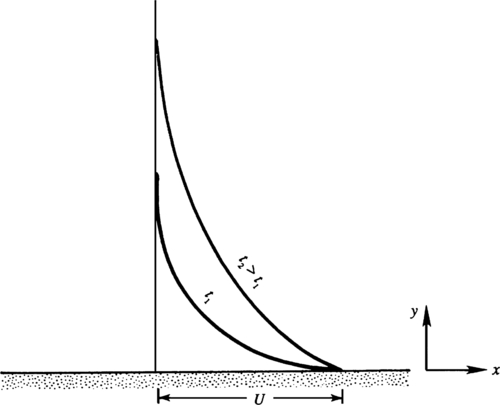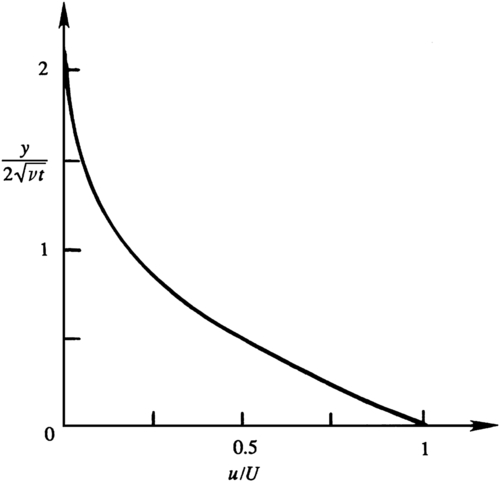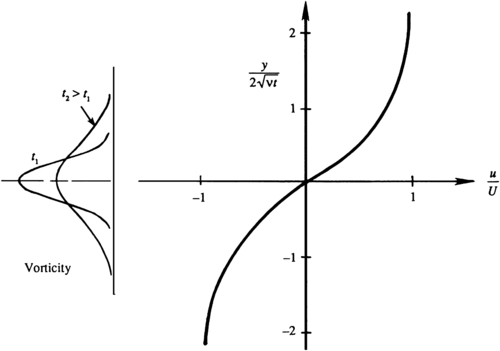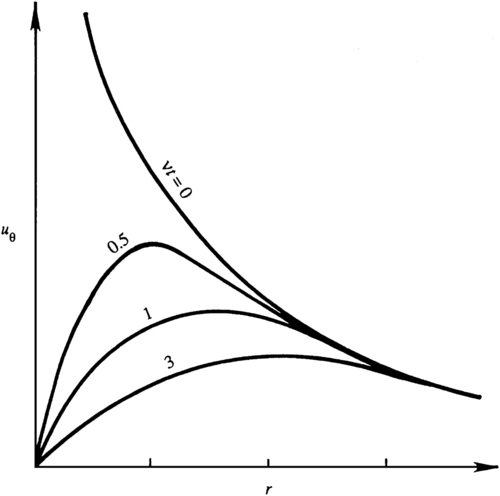9.4. Similarity Solutions for Unsteady Incompressible Viscous Flow
Similarity solutions to partial differential equations are possible when a variable transformation exists that allows the partial differential equation to be rewritten as an ordinary differential equation. Several such solutions for the Navier-Stokes equations are presented in this section.
So far, steady flows with parallel, or nearly parallel, streamlines have been considered. In this situation, the nonlinear advective acceleration is zero, or small, and the stream-wise velocity reduces to a function of one spatial coordinate, and time. When a viscous flow with parallel or nearly parallel streamlines is impulsively started from rest, the flow depends on the spatial coordinate(s) and time. For such unsteady flows, exact solutions still exist because the nonlinear advective acceleration drops out again (see Exercise 9.41). In this section, several simple and physically revealing unsteady flow problems are presented and solved. The first is the flow due to impulsive motion of a flat plate parallel to itself, commonly known as Stokes’ first problem. (The flow is sometimes unfairly associated with the name of Rayleigh, who used Stokes’ solution to predict the thickness of a developing boundary layer on a semi-infinite plate.)
A similarity solution is one of several ways to solve Stokes’ first problem. The geometry of this problem is shown in Figure 9.12. An infinite flat plate lies along y = 0, surrounded by an initially quiescent fluid (with constant ρ and μ) for y > 0. The plate is impulsively given a velocity U at t = 0 and constant pressure is maintained at x = ±∞. At first, only the fluid near the plate will be drawn into motion, but as time progresses the thickness of this moving region will increase. Since the resulting flow at any time is invariant in the x direction (∂/∂x = 0), the continuity equation ∂u/∂x + ∂v/∂y = 0 requires ∂v/∂y = 0. Thus, it follows that v = 0 everywhere since it is zero at y = 0. Therefore, the simplified horizontal and vertical momentum equations are:

Figure 9.12 Laminar flow due to a flat plate that starts moving parallel to itself at speed U at t = 0. Before t = 0, the entire fluid half-space (y > 0) was quiescent. As time progresses, more and more of the viscous fluid above the plate is drawn into motion. Thus, the flow profile with greater vertical extent corresponds to the later time.

Just before t = 0, all the fluid is at rest so p = constant. For t > 0, the vertical momentum equation only allows the fluid pressure to depend on x and t. However, at any finite time, there will be a vertical distance from the plate where the fluid velocity is still zero, and, at this vertical distance from the plate, ∂p/∂x is zero. However, if ∂p/∂x = 0 far from the plate, then ∂p/∂x = 0 on the plate because ∂p/∂y = 0. Thus, the horizontal momentum equation reduces to:
 (9.20)
(9.20)
subject to the boundary and initial conditions:
 (9.21, 9.22, 9.23)
(9.21, 9.22, 9.23)
The problem is well posed because (9.22) and (9.23) are conditions at two values of y, and (9.21) is a condition at one value of t; this is consistent with (9.20), which involves a first derivative in t and a second derivative in y.
The partial differential equation (9.20) can be transformed into an ordinary differential equation by switching to a similarity variable. The reason for this is the absence of enough other parameters in this problem to render y and t dimensionless without combining them. Based on dimensional analysis (see Section 1.11), the functional form of the solution to (9.20) can be written:
 (9.24)
(9.24)
where f is an undetermined function. However, (9.20) is a linear equation, so u must be proportional to U. This means that the final dimensionless group in (9.24) must be dropped, leaving:
 (9.25)
(9.25)
where F is an undetermined function, but this time it is a function of only one dimensionless group and this dimensionless group η = y/(νt)1/2 combines both independent variables. This reduces the dimensionality of the solution space from two to one, an enormous simplification.
Equation (9.25) is the similarity form for the fluid velocity in Stokes’s first problem. The similarity variable η could have been defined differently, such as νt/y2, but different choices for η merely change F, not the final answer. The chosen η allows F to be interpreted as a velocity profile function with y appearing to the first power in the numerator of η. At any fixed t > 0, y and η are proportional.

and these can be combined to provide the equivalent of (9.20) in similarity form:
 (9.26)
(9.26)
 (9.27, 9.28)
(9.27, 9.28)
because (9.21) and (9.23) reduce to the same condition in terms of η. This reduction is expected because (9.20) is a partial differential equation and needs two conditions in y and one condition in t to be solved, while (9.26) is a second-order ordinary differential equation and needs only two boundary conditions to be solved. Equation (9.26) is readily separated:

and integrated to reach:

where A is a constant. Integrating again leads to:

where ξ is just an integration variable and B is another constant. The condition (9.27) sets B = 1, while condition (9.28) gives:

 where the tabulated integral
where the tabulated integral  has been used. The final solution for u then becomes:
has been used. The final solution for u then becomes: (9.30)
(9.30)
is the error function and again ξ is just an integration variable. The error function is a standard tabulated function (see Abramowitz & Stegun, 1972). Equation (9.30) is the solution to the problem and the form of (9.30) makes it is apparent that the velocity profile at different times will collapse into a single curve of u/U vs. η, as shown in Figure 9.13.
The nature of the variation of u/U with y for various values of t is sketched in Figure 9.12, and this solution has a diffusive nature. At t = 0, a vortex sheet (that is, a velocity discontinuity) is created at the plate surface. The initial vorticity is in the form of a delta function, which is infinite at the plate surface and zero elsewhere. The integral ∫ 0 ∞ ω d y = ∫ 0 ∞ ( − ∂ u / ∂ y ) d y = – U  is independent of time, so no new vorticity is generated after the initial time. The flow given by (9.30) occurs as the initial vorticity diffuses away from the wall. The situation is analogous to a heat conduction problem in a semi-infinite solid extending from y = 0 to y = ∞. Initially, the solid has a uniform temperature, and at t = 0 the face at y = 0 is suddenly brought to a different temperature. The temperature distribution for this heat conduction problem is given by an equation similar to (9.30).
is independent of time, so no new vorticity is generated after the initial time. The flow given by (9.30) occurs as the initial vorticity diffuses away from the wall. The situation is analogous to a heat conduction problem in a semi-infinite solid extending from y = 0 to y = ∞. Initially, the solid has a uniform temperature, and at t = 0 the face at y = 0 is suddenly brought to a different temperature. The temperature distribution for this heat conduction problem is given by an equation similar to (9.30).
 is independent of time, so no new vorticity is generated after the initial time. The flow given by (9.30) occurs as the initial vorticity diffuses away from the wall. The situation is analogous to a heat conduction problem in a semi-infinite solid extending from y = 0 to y = ∞. Initially, the solid has a uniform temperature, and at t = 0 the face at y = 0 is suddenly brought to a different temperature. The temperature distribution for this heat conduction problem is given by an equation similar to (9.30).
is independent of time, so no new vorticity is generated after the initial time. The flow given by (9.30) occurs as the initial vorticity diffuses away from the wall. The situation is analogous to a heat conduction problem in a semi-infinite solid extending from y = 0 to y = ∞. Initially, the solid has a uniform temperature, and at t = 0 the face at y = 0 is suddenly brought to a different temperature. The temperature distribution for this heat conduction problem is given by an equation similar to (9.30).We may arbitrarily define the thickness of the diffusive layer as the distance at which u falls to 1% of U. From Figure 9.13, u/U = 0.01 corresponds to y/(νt)1/2 = 3.64. Therefore, in time t the diffusive effects propagate to a distance of:
 (9.31)
(9.31)
which defines the 99% thickness of the layer of moving fluid and this layer's thickness increases as t1/2. Obviously, the factor of 3.64 is somewhat arbitrary and can be changed by choosing a different ratio of u/U as the definition for the edge of the diffusive layer. However, 99% thicknesses are commonly considered in boundary layer theory (see Chapter 10).
Stokes’ first problem illustrates an important class of fluid mechanical problems that have similarity solutions. Because of the absence of suitable scales to render the independent variables dimensionless, the only possibility was a combination of variables that resulted in a reduction in the number of independent variables required to describe the problem. In this case the reduction was from two (y,t) to one (η) so that the formulation reduced a partial differential equation in y and t to an ordinary differential equation in η.

Figure 9.13 Similarity solution of laminar flow due to an impulsively started flat plate. Using these scaled coordinates, all flow profiles like those shown on Figure 9.12 will collapse to the same curve. The factor of two in the scaling of the vertical axis follows from (9.30).
The solution (9.30) for u(y,t) is self-similar in the sense that at different times t1, t2, t3, … the various velocity profiles u(y,t1), u(y,t2), u(y,t3), … fall on a single curve if u is scaled by U and y is scaled by the diffusive thickness (νt)1/2. Moreover, such a collapse will occur for different values of U and for fluids having different ν.
Similarity solutions arise in situations in which there are no imposed length or time scales provided by the initial or boundary conditions (or the field equation). A similarity solution would not be possible if, for example, the boundary conditions were changed after a certain time t1 since this introduces a time scale into the problem (see Exercise 9.40). Likewise, if the flow in Stokes’ first problem was bounded above by a second parallel plate, there could be no similarity solution because the distance to the second plate introduces a length scale into the problem.
Similarity solutions are often ideal for developing an understanding of flow phenomena, so they are sought wherever possible. A method for finding similarity solutions starts from a presumed form for the solution:
 (9.32a,b)
(9.32a,b)
where γ is the dependent field variable of interest, (a velocity component, for example), A is a constant (units = [γ] × [time]n or [γ] × [length]n), ξ is the independent spatial coordinate, t is time, η = ξ/δ is the similarity variable, and δ(t) is a time-dependent length scale (not the Dirac delta-function). The factor of At–n or Aξ–n that multiplies F in (9.32) is sometimes needed for similarity solutions that are infinite (or zero) at t = 0 or ξ = 0. Use of (9.32) is illustrated in the following examples.
After reviewing these examples, it should be clear that diffusive length scales in unsteady viscous flow are proportional to (νt)1/2. The viscous bead-spreading example produces a length scale with a different power, but this is not a diffusion time scale. Instead it is an advection time scale that specifies how far fluid elements travel in the direction of the flow.

































